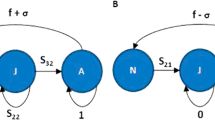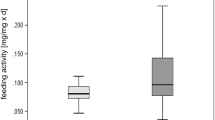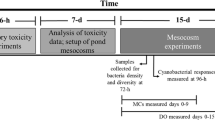Abstract
Ecotoxicity studies using two glyphosate-based formulations (Eskoba® and Sulfosato Touchdown®) were undergone with three microcrustacean species to establish their LC50 values and to evaluate the efficacy of cleaning treatments with UV/H2O2.Samples were collected at the beginning of the process −50 mg acid equivalent per liter of glyphosate without H2O2 and at different treatment timepoints: 2, 4, and 6 h. Three microcrustacean species were used as biological models.The Eskoba® LC50 ranged between 14.49 and 95.23 acid equivalents (a.e.) mg L−1and for Sulfosato Touchdown® between 0.31 and 1.74 a.e. mg L−1. The glyphosate-based formulations registered the following order of sensitivities: Ceriodaphnia dubia > Daphnia magna > Notodiaptomus conifer. The treatment duration and mortality (%) were negative and significantly correlated for both formulations, indicating that the remediation process diminished the glyphosate concentration. Therefore, microcrustacean mortality decreased linearly with the remediation time. C. dubia and N. conifer were more sensitive than the holarctic D. magna to the remediation process, since the first two species showed greater percentage of mortality at 6 h of processes, compared with D. magna, for both formulations evaluated. Sulfosato Touchdown® was more toxic but showed greater degradability than Eskoba®. The results provide relevant information regarding (1) the urgency to clearly identify the additives on product labels, (2) the efficiency of UV/H2O2 process for reducing adverse effects of two glyphosate-based formulations, and (3) the importance of developing studies to evaluate the effectiveness of cleaner technologies with an emphasis on microcrustacean species as biological models.





Similar content being viewed by others
References
Alberdi, J. L., Saenz, M. E., Di Marzio, W. D., & Tortorelli, M. C. (1996). Comparative acute toxicity of two herbicides, paraquat and glyphosate, to daphnia magna and daphnia spinulata. Bull Environ Contam Toxicol, 57(2), 229–235.
Altieri M & Pengue W. (2006). GM soybean: Latin America’s new coloniser. Seedling (January), 13–17. www.grain.org/seedling. Accessed 15 June 2015.
American Public Health Association (APHA), et al. (1998). Standard methods for the examination of water and wastewater (20th ed.). Washington D.C. EstadosUnidos: Ap. 8010G.
Appendices to Glyphosate. (2010). Human health and ecological risk assessment. Southern Region. USA: USDA/Forest Service.
AshokaDeepananda, K. H. M., Gajamange, D., De Silva, W. A. J. P., & Wegiriya, H. C. E. (2011). Acute toxicity of a glyphosate herbicide, Roundup®, to two freshwater crustaceans. J NatlSci Found Sri Lanka, 39, 169–173.
Cuhra, M., Traavik, T., & Bohn, T. (2013). Clone- and age-dependent toxicity of a glyphosate commercial formulation and its active ingredient in Daphnia magna. Ecotoxicology, 22, 251–262.
Demetrio, P. M., Bulus Rossini, G., Bonetto, C., & Ronco, A. (2012). Effects of pesticide formulations and active ingredients on the coelenterate Hydra attenuata (Pallas, 1766). Bull Environ ContamToxicol, 88, 15–19.
Dill, G. M., Sammons, R. D., Feng, P. C. C., Kohn, F., Kretzmer, K., Mehrsheikh, A., Bleeke, M., Honegger, J. L., Farmer, W. D., & Haupfear, E. A. (2010). Glyphosate: discovery, development, applications, and properties. In Glyphosate resistance in crops and weeds: history, development, andmanagement (pp. 1–33). New York: Inc, Nandula VK, Wiley.
Dominguez-Cortinas, G., Mejía-Saavedra, J., Santos-Medrano, G. E., & Rico-Martínez, R. (2008). Analysis of the toxicity of glyphosate and Faena® using the freshwater invertebrates Daphnia magna and Lecane quadridentata. Toxicol Environ Chem, 90, 377–384.
Dutra, B. K., Fernandes, F. A., Failace, D. M., & Oliveira, G. T. (2011). Effect of Roundup®(glyphosate formulation) in the energy metabolism and reproductive traits of Hyalella castroi (Crustacea, Amphipoda, Dogielinotidae). Ecotoxicology, 20, 255–263.
Fernández-Alba, A., Hernando, D., Agüera, A., Cáceres, J., & Malato, S. (2002). Toxicity assays: a way for evaluating AOPs efficiency. Water Res, 36, 4255–4262.
Finney, D. J. (1971). Probit analysis (3rd ed.). Cambridge: University Press.
FAOSTAT. (2013) http://faostat3.fao.org/download/Q/QC/E (access 18 March 2015).
Gagneten, A. M., Maitre, M. I., Reno, U., Regaldo, L., Roldan, S., & Enrique, S. (2014). Efectos del Herbicida Ron-Do® sobre Cerodaphnia reticulata (Crustacea, Cladocera) y Degradabilidad del Glifosato (N fosfometilglicina) en Condiciones Experimentales. Nat Neotrop Nro, 45, 71–85.
InfoStat. (2004). Grupo Infostat. FCA. Universidad Nacional de Córdoba. 1ra eds. Argentina: Editorial Brujas.
International Organization for Standardation. ISO 6341. (1996). Water quality: determination of the inhibition of the mobility of Daphnia magna Straus (Cladocera, Crustacea): acute toxicity test. 3rd Edition. USA, 7.
Junges, C. M., Vidal, E. E., Attademo, A. M., Mariani, M., Cardell, L., Negro, A. C., Cassano, A., Peltzer, P., Lajmanovich, R., & Zalazar, C. S. (2013). Effectiveness evaluation of glyphosate oxidation employing the H2O2/UVC process: Toxicity assays with Vibrio fischeri and Rhinella arenarum tadpoles. J. of Environ Sci and Health. Bull Am Meteorol Soc, 48, 163–170.
Kitulagodage, M., Astheimer, L. B., & Buttemer, W. A. (2008). Diacetone alcohol, a dispersal solvent, contributes to acute toxicity of a fipronil-based insecticide in a passerine bird. Ecotoxicol Environ, 71, 597–600.
Lajmanovich, R., Attademo, A., Peltzer, P., Junges, C., & Cabagna, M. (2011). Toxicity of four herbicide formulations with glyphosate on Rhinella arenarum (Anura: Bufonidae) tadpoles: B-esterases and glutathione–S-transferase inhibitors. Arch Environ Contam Toxicol, 60, 681–689.
Lanctôta, C., Navarro-Martína, L., Robertsona, C., Park, B., Jackmanc, P., Paulid, B. D., & Trudeau, V. L. (2014). Effects of glyphosate-based herbicides on survival, development, growth and sex ratios of wood frog (Lithobates sylvaticus) tadpoles. II: agriculturally relevant exposures to Roundup WeatherMax® andVision® under laboratory conditions. Aquat Toxicol, 154, 291–303.
Manassero, A., Passalía, C., Negro, A. C., Cassano, A. E., & Zalazar, C. S. (2010). Glyphosate degradation in water employing the H2O2/UVC process. Water Res, 44, 3875–3882.
MangatEchavia, G. R., Matzusawa, F., & Negishi, N. (2009). Photocatalytic degradation of organophosphate and phosphonoglycine pesticides using TiO2 immobilized on silica gel. Chemosphere, 76, 595–600.
Mc Laughlin, A., & Mineau, P. (1995). The impact of agricultural practices on biodiversity Agr. Ecosyst Environ, 55, 201–212.
Mesnage, R., Defarge, N., Spiroux de Vendômois, J., Séralini, G.E. (2014). Major pesticides are more toxic to human cells than their declared active principles. BioMed Research International, 2014, ID 179691. 1-8.
Neder, S., Negro, A., Cassano, A., & Zalazar, C. (2011). Photodegradation of glyphosate acid and its commercial formulations in water. Paris, France: IOA IUVA World Congress & Exhibition.
Pereira, J. L., Antunes, S. C., Castro, B. B., Marques, C. R., Gonclaves, A. M. M., Gonclaves, F., & Pereira, R. (2009). Toxicity evaluation of three pesticides on non-target aquatic and soil organisms: commercial formulation versus active ingredient. Ecotoxicology, 18, 455–463.
Piola, L., Fuchs, J., Oneto, M. L., Basack, S., Kesten, E., & Casabé, N. (2013). Comparative toxicity of two glyphosate based formulations to Eisenia andrei under laboratory conditions. Chemosphere, 91, 545–551.
Olvera-Ramírez, R., Centeno-Ramos, C., & Martínez-Jerónimo, F. (2010). Toxic effects of Pseudanabaena tenuis (Cyanobacteria) on the cladocerans Daphnia magna and Ceriodaphnia dubia. Hidrobiológica, 20, 203–212.
Raipulis, J., Toma, M. M., & Balode, M. (2009). Toxicity and genotoxicity testing of roundup. Proceedings of the latvian academy of sciences, 63, 29–32.
Rand, G. M., & Petrocelli, S. R. (1985). Fundamentals of aquatic toxicology (p. 666). Washington: Hemisphere Publishing Corporation.
Regaldo, L. (2013). Thesis: effect of heavy metals and pesticides on planktonic organisms different trophic level and efficiency of accumulation by microalgae. Argentina: UNL.
Reno, U., Gutierrez, M. F., Regaldo, L., & Gagneten, A. M. (2014). The impact of Eskobat, a glyphosate formulation, on the freshwater plankton community. Water Environment Research, Vol, 86(12), 2294–2300.
Rodríguez, A., & Jacobo, E. (2010). Glyphosate application changes plant functional groups proportion and reduces floristic richness and diversity in Flooding Pampa rangeland (Argentina). Agriculture, Ecosystems and Environment, 138(3–4), 222–231.
Romero, D. M., Ríos de Molina, M. C., & Juárez, A. B. (2011). Oxidative stress induced by a commercial glyphosate formulation in a tolerant strain of Chlorella kessleri. Ecotoxicol Environ Safe, 74, 741–747.
Tsui, M. T. K., & Chu, L. M. (2003). Aquatic toxicity of glyphosate-based formulations: comparison between different organisms and the effects of environmental factors. Chemosphere, 52, 1189–1197.
Tsui, M. T. K., & Chu, L. M. (2004). Comparative toxicity of glyphosate-based herbicides: aqueous and sediment pore water exposures. Arch Environ ContamToxicol, 46, 316–323.
Vidal, E., Negro, A., Cassano, A., & Zalazar, C. (2015). Simplified reaction kinetics, models and experiments for glyphosate degradation in water by the UV/H2O2 process. Photochem Photobiol Sci, 14, 366–377.
Acknowledgments
This research was supported by grants from the National University of the Littoral, CONICET, and ANPCyT
(Project CAI + D Orientado 1.6 and from the Santa Fe Province, Project SECTeI 2.1-28-11).
Author information
Authors and Affiliations
Corresponding author
Rights and permissions
About this article
Cite this article
Reno, U., Gutierrez, M.F., Longo, M. et al. Microcrustaceans: biological models to evaluate a remediation process of glyphosate-based formulations. Water Air Soil Pollut 226, 349 (2015). https://doi.org/10.1007/s11270-015-2616-y
Received:
Accepted:
Published:
DOI: https://doi.org/10.1007/s11270-015-2616-y




